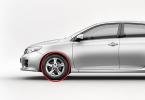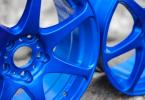Certified installation center All work performed on the site is certified. That is why the refusal to warranty service from the side of the car dealership it is illegal and car dealers do not deprive the guarantee of the cars equipped with us.
Installment plan for 6 months.
from 7 607 rub. per month A website in the city of St. Petersburg from 5,000 rubles can be provided when purchasing goods and services of the company. Detailed information can be obtained from the company's installation centers.
3 years warranty
to install The quality of the work performed, the site allows you to provide the guarantee necessary for long-term operation vehicle... After the work performed optional equipment will work properly in accordance with the manufacturer's warranty, all defects in the work are eliminated free of charge within 3 years.
Description Webasto Thermo Top Evo 5 Diesel
Webasto Thermo Top Evo 5 Diesel is designed for installation on vehicles with engine displacement from 2.0 to 4.0 liters.
Advantages of the Thermo Top Evo 5 Diesel preheater:
Vehicle-mounted preheater Webasto Thermo Top evo 5 is characterized by fast heating. Installed system heating saves motorists from most of their daily problems - in a preheated cabin, the driver can easily start the engine with comfort. In addition, the car does not need to be de-iced. Webasto provides not only prompt heating of the passenger compartment, but also relieves the glass from condensation that forms on their inner surface.
In addition to its warm-up speed and efficiency, the Evo 5 has low consumption fuel and light load on the vehicle's battery. Due to the fact that the heater does not load standard system heating the vehicle, the battery is still charged. This reduces fuel consumption and the concentration of harmful emissions.
In the event of a fall onboard voltage in the car, the air blower maintains stability of operation, therefore, the preheater Webasto Thermo Top Evo 5 maintains its performance. The heater is turned off only when the voltage drops at the moment of start and during the specified operating mode upon reaching threshold values... Thus, the security of the system and stable work Webasto Thermo Top Evo 5 guarantees trouble-free starting of the engine.
Installation:
The heater is installed according to the principle of most of such devices - in engine compartment under the hood of the car. For his work, he "draws" fuel from the tank of the car, which, as experience shows, is very convenient and typical for most devices from the Webasto company.
Works paid separately
- Dismantling / assembly fuel tank- from 2000 rubles.
- Removal / installation of a bumper - from 1500 rubles.
- Connecting the interior fan - from 1500 rubles.
- Climate control connection - from 3500 rubles.
- Manufacturing protection (when mounted under the bottom) - from 1500 rubles.
- Dismantling / installation of non-standard equipment (siren, kengurin, crankcase protection, additional optics, etc. are paid separately based on the complexity of the work;
- Possible add. work - 1000 rubles / standard hour.
ATTENTION! This service may be applicable for a certain lineup cars, so before by installing Webasto Thermo Top Evo 5 (diesel, 12V) contact a convenient installation center for you, and our expert will answer all your questions.
To get a consultation
The heater is usually installed in the engine compartment in the area between the wheel housing and the front bumper and is mounted as low as possible to ensure self-deletion air from the heater and circulation pump.
The heater must not be installed:
- in the area of direct thermal effect of the exhaust system
- below the ford level of the vehicle
- above the coolant expansion tank.
Compliance with the mounting positions is mandatory!
The heater is fixed to the bracket with at least 3 M5 screws with a tightening torque of 8 Nm. The standard bracket is attached with a minimum of 4 M6 screws to the vehicle body or to an intermediate bracket. It is forbidden to fasten the bracket to the body with self-tapping screws. If necessary, it is allowed to technically correct the bracket.

10 - Liquid heater 26 - Heater bracket 27 - Body
An example of installing a heater on a car: 1) Radiator. 2) Coolant thermostat. 3) Water pump. 4) Engine internal combustion... 5) Exhaust gas muffler. 6) Muffler and inlet pipeline combustion air. 7) Circulation pump. eight) Accumulator battery... 9) Fuse holder. 10) Liquid heater. 11) Control unit (in the heater). 12) Mechanical shut-off valve. 13) Fan of the vehicle heating system. 14) Heat exchanger of the vehicle heating system. 15) Switch of the fan of the car heating system. 16) Fuse box in the car. 17) Car fan relay. 18) Control panel. 19) Dispensing fuel pump... 20) Fuel intake

The heater is connected to the vehicle cooling system in accordance with the diagram, where 1) Radiator. 4) Internal combustion engine. 7) Circulation pump. 10) Liquid heater. 14) Heat exchanger of the vehicle heating system. 28) Expansion tank. 29) Thermostat

The circulation pump (liquid pump) is installed in accordance with the diagram:

The amount of coolant in the circuit must be at least 1.5 liters. The connection of the heater to the cooling system is usually carried out at the inlet of the heat exchanger. Collect escaping coolant in a suitable container. Always use coolant hoses supplied by Webasto. Otherwise, the hoses must at least comply with DIN 73411, material class B. Hoses must be routed without kinks and, if possible, with a rise from the heater for unimpeded air removal. The inner diameter of the hoses must be 18 mm. Secure the hose connections with clamps to prevent slipping.
Installation of fittings.
Never mount the mounting plate and fittings on installed heater ... The contact surfaces of the O-rings in the heat exchanger must be clean and free of damage. Moisten before installing o-rings water. Place the O-rings in the holes in the heat exchanger. Insert the fittings into the base plate. Install the unions in the required position, in accordance with the diagram.

Fasten the base plate with fittings to the heat exchanger. Self-locking screw DG 5X15 mm, tightening torque 7 Nm. For self-bleeding of the heater, the water outlet should be directed upwards by 0 -90 °, if possible. Follow correct position coolant temperature sensor wires.

21) Heat exchanger inlet. 22) Heat exchanger outlet. 30) Sensor wire.
Hose installation
Clamps on the heat exchanger fittings should be installed between the boss of the fitting and the hose stop. Before starting the heater for the first time and after changing the coolant, ensure that the cooling system is thoroughly vented. The heater and piping must be installed in such a way that static air removal is ensured. Insufficient air removal can lead to malfunctions due to overheating during heater operation.
Circulation pump installation
The circulation pump is installed in the cooling circuit with the discharge side to the inlet of the preheater heat exchanger. Observe the direction of flow of the circulation pump towards the vehicle cooling circuit. The installation position of the circulation pump must be chosen so that it can be independently vented. The air from the pump must go up through the fittings. Incorrect installation can lead to malfunctions of the pump.
Control
After installing the heater and all components of the cooling system, it is necessary to check its tightness with the pressure prescribed by the car manufacturer.
Connecting to fuel system
The connection is made either to the supply or return line or through a special fuel intake in the tank. On vehicles with a fuel pump, the fuel must not be taken from the supply line! If the car has check valve on the return line to the tank, you must not take fuel from the return line. It must be ensured that there is no shortage of fuel in the vehicle's fuel system due to the withdrawal of fuel for the heater. - When withdrawing from the intermediate tank, it must be ensured that it is not empty. Correct installation carried out in accordance with the scheme, where 33) from the tank. 34) to the metering pump. 35) to the engine

The connection can also be carried out through the fuel intake unit, in accordance with the diagram, where 31) Fuel pickup from the tank. 32 Fuel pick-up unit with hole

The mounting surface of the fuel pickup must be clean, level and free of burrs. When using a fuel pickup in the fuel pickup assembly, the riser tube must be carefully installed. It should not affect the operation of the parts of the fuel pick-up unit, including the fuel level indication. The length of the lifting tube should be chosen so that, when assembled, the distance to the bottom of the tank is at least 10 mm or 20 mm to the bottom of the fuel pick-up unit. Observe the safety measures prescribed by the vehicle manufacturer and the tightening torques threaded connections. The fuel extractor should only be installed in the fuel pick-up unit, it should not under any circumstances be installed in the tank body.
Fuel line.
The fuel line is divided into a suction line and a pressure line. The suction line connects the tank to the metering pump, and the pressure line runs from the metering pump to the heater. The length of the fuel line should be as short as possible. The fuel line must be protected from damage along its entire length. Route the fuel line in a cool area to avoid the formation of bubbles due to heating. Heat fuel can cause the heater to malfunction. Therefore, the fuel line must not run near strong heat sources (e.g. exhaust systems) or in areas of aerodynamic heating. If possible, the fuel line should be laid with a rise from the tank to the heater. Fasten the fuel line so that it does not sag. Use abrasion protection when crossing sharp edges. Do not lay the fuel line inside the vehicle.
Connecting two pipes with a hose
The correct connection of the fuel lines with a hose is shown in the figure, where41) Clamp. 42) Air bubble

Check the tightness of the connections!
Dosing pump.
The dosing pump is a combined delivery, dosing and shut-off element that must meet certain installation criteria.

The dosing pump must not be installed in the heat affected area of hot vehicle parts. If necessary, use thermal insulation. The preferred location is near the tank. The dosing pump must be mounted on a vibration-damping suspension. The mounting position restrictions are shown in the figure above. ( maximum angle tilt, axial position), thus ensuring good removal air. The arrow shows the direction of fuel flow.
A memo must be attached at the location of the filler neck, warning that the heater must be turned off before refueling. Use the stickers supplied. Affix the sticker “Turn off the heater while refueling” near the fuel filler neck. When switching to winter fuel the heater must be turned on for about 15 minutes so that the fuel lines and the fuel pump are filled with new fuel.
Combustion air supply
The air intake must be located or protected in such a way that it is not likely to be blocked by debris or balance. The air intake must be positioned so that the intake air is not contaminated. It should not be directed in the direction of travel. An intake manifold is required to supply combustion air. The air intake must be from a cool, splash-proof location above the ford level of the vehicle. If the air intake is in an enclosed space, then a ventilation hole of at least 3 cm2 is required.
Exhaust system
The flue gas pipe (inner diameter 22 mm) can be laid with several turns (total 270 °, smallest bend radius 50 mm) The total length of the pipe must be between 500 and 1000 mm. The Thermo Top Evo must not be operated without an exhaust silencer. The muffler must not be located close to the combustion air intake. The muffler should be installed at a distance of at least 200 mm from the heater. Make a hole ø 2 mm to drain the condensate into the bottom point muffler.

The muffler and exhaust pipe must not be attached to temperature-sensitive vehicle parts (brake pipes, electrical wires, vehicle controls, headlights, engine underbody protection, plastic parts, etc.) and must be at least 20 mm away from them. Only spacers approved by Webasto for this purpose may be used. The exhaust pipe must be sufficiently secured to maintain the minimum distances indicated above, even when the vehicle is in motion. Only pipes approved by Webasto may be used for the exhaust gas discharge. It is recommended to install an exhaust system protected from splashes.
It is necessary to ensure the drainage of condensate from the pipes. If necessary, it is permissible to make a condensate drain hole at the lowest point of the system.Outlet pipe of the exhaust system exhaust gases must be located so that the possibility of exhaust gases getting inside the vehicle through fans, air intakes of the heating system or open windows is excluded.
The exhaust gas outlet must be free of obstacles. Gases must not be directed at vehicle parts. Exhaust gases are not allowed to escape in the area of the wheel arch. Consider the maximum steering angle of the front wheels. Locate the flue gas outlet so that it cannot be clogged or damaged under any operating conditions. The end of the exhaust pipe must not be guided in the direction of the vehicle. The exhaust gas flow must be directed vertically downward or at an inclination of no more than 20 ° against the direction of travel of the vehicle. After passing through the lower engine guard exhaust pipe should protrude another 10 mm.

Electrician.
Electrical components such as relays, fuses, switches, etc. must be installed in such a way that they are protected from penetrating water (splashing water, water from a pressure washer ...).
The electrical connection of the heater is carried out in accordance with the diagram. The timer is also connected according to this scheme.

Explanations for the diagram.

First start
Follow the safety instructions in the operating instructions and maintenance! Before starting up the heater, be sure to read the operating and maintenance instructions.
After installing the heater, thoroughly bleed the air from the cooling system and the fuel system. When doing so, observe the instructions of the vehicle manufacturer.
These installation instructions do not contain all necessary information and recommendations for the installation of Thermo Top Evo liquid heaters. In addition, use the operating instructions and installation instructions for the specific vehicle.
Thermo Top Evo, depending on the model, can run on petrol or diesel fuel and is intended for heating the car interior, helping in defrosting windows, preheating car engine liquid cooling.
Switching on and starting process of liquid preheater Webasto Thermo Top Evo.
The launch occurs through a turn-on signal from the control. The pre-heater starts when an input signal appears. The appearance of the input signal depends on predefined switching conditions such as outside temperature and the operation of the car engine. When the Thermo Test PC diagnostics is connected, other controls are disabled.
When the heater is started, the blower, circulation pump and glow plug start to function. Then the metering pump turns on. The Webasto Thermo Top Evo petrol heater starts at maximum load. Diesel Webasto Thermo Top Evo starts at minimum load and slowly accelerates to maximum load.
During the start phase, the glow plug monitors the formation of the flame. If the flame does not appear, or is cut off during the start-up process, then this leads to a restart. If the flame does not appear again, the start attempts are terminated. The pre-heater is turned off by the appearance of an error and blowing the blower.
The heater can only be put into operation after it has been turned off. Depending on the temperature of the liquid, the control unit selects the start phase. The start-up stages are identical in terms of the sequences, differ only in the duration of the individual phases (warm-up, fuel supply, etc.).
Heating mode of the liquid pre-heater Webasto Thermo Top Evo.
After entering the mode maximum load The glow plug performs the monitoring function of the flame sensor. After reaching a certain temperature (about 80 degrees), the heater switches to the energy-saving partial load mode.
If the temperature reaches the set switching point again, the heater switches back to the control pause mode. If the coolant temperature drops due to increased heat extraction at partial load, the heater will return to full load.
The switching point temperatures are programmed in the control unit. If, during the normal combustion process, a flame break occurs, an automatic restart occurs.
Restarting the Webasto Thermo Top Evo liquid preheater after shutdown with an error.
After the cause of the error has been eliminated, the heater is switched on again with a normal start signal. This does not happen after overheating or a repeated error with no intermediate normal modes burning.
Starting the Webasto Thermo Top Evo liquid preheater after a long period of inoperability.
Prolonged inoperability has no effect on the heater start-up process. The only caveat to this may be the filling of the highway. Especially petrol heaters are susceptible to partial vaporization of the fuel in the lines in the summer, so when starting up for the first time, several complete starting attempts must be taken into account.
Commissioning can also be carried out using the Thermo Test PC diagnostics. With its help, you can pump fuel through the highway. Fill the fuel line up to the heater using the "Bleed line" button.
Turning off and stopping the Webasto Thermo Top Evo liquid preheater.
The combustion process stops when receiving a signal to turn off, when the maximum combustion temperature is reached, when the set operating time is reached, or when an error occurs. In this case, the control of the metering pump is immediately terminated and the rotation speed of the blower is reduced.
After a successful burnout to cool down, the fan speed of the blower increases again. Purge time and blower fan speed depend on the type of heater and the operating state at which the heater is turned off.
Turn-off and turn-on signals are processed according to the following rules:
1. The signal to turn off always comes from the control.
2. If the initial switch-on signal no longer exists or the set operating time has elapsed, this is interpreted as a switch-off signal.
3. The new start signal is ignored until there is no more initial start signal.
4. Changing the heating time during operation is not possible. The heating must be turned off and restarted with the changed heating time.
5. If the heating was started as a re-heater, then the stop will be interpreted as a signal to turn off.
6. The heater can be restarted only after the combustion is completed and the first cooling stage is completed (forced blowdown). The repeated turn-on signal is still stored in intermediate memory and is not executed.
This model of preheater is outdated. ...
Warm up the engine.
The pre-heater Webasto Thermo Top Evo 4 (diesel) is the original German equipment for installation on cars with diesel engine volume up to 2 liters. Designed for autonomous warming up of the engine and car interior before the start of the trip. That is, to warm up the car, it is not required to start it, which eliminates the problem of cold start. Small dimensions allow the heater to be installed on a O most small cars, where there is already little space under the hood. This model of preheater incorporates the most modern technologies and developments. For example, the heater uses a new battery discharge control system that will prevent it from starting if the battery level is below acceptable value, quick start system and more efficient fuel consumption. Also, the heater Webasto Thermo Top Evo 4 (diesel) is adapted for use in the conditions of the Russian winter and severe frosts.
Heating up the passenger compartment.
To implement the function of heating the passenger compartment in many cars, an additional matching module (Fan Control or iPCU, depending on the model) must be installed to control climate control, which turns on as soon as the engine coolant warms up to the desired level (60 0 С). However, some car models do not require such a module. You can learn more about this from our managers.
Governing bodies.
There are three ways to control Webasto pre-heaters: using a timer, a remote control and a mobile application (GSM module). From the point of view of comfort, it is most convenient to operate with mobile app(GSM module) from almost any smartphone model. It is also possible to install non-original equipment and
Guarantee.
2 years for all installation and equipment work!
The company's equipment is currently a recognized leader among pre-heaters and continues to firmly hold its leading position due to the highest quality.
For ease of installation, the heater Webasto Thermo Top Evo 4 (diesel) is supplied with the necessary accessories. The fittings provide easy connection of hoses in any position. The circulation pump can be installed separately or together with a heater block. Thanks to the brackets, the heater can be installed on any suitable interior surface of the vehicle.
Prestarting heaters of Webasto engines Thermo series Top are designed for installation on passenger cars and can be used for:
- engine heating at low temperatures for safe launch
- warming up the cabin and windshield(to remove icing) when idle engine
- additional heating of the engine and passenger compartment when the engine is running in severe frost conditions
The principle of operation of the heater
Autonomous Thermo heaters Top Evo works independently of the vehicle's engine. The heater is connected to the vehicle battery and fuel system. The principle of operation is based on heating the liquid in the engine cooling system, forcibly pumped through the heat exchange system of the heater.
Heater operation is monitored electronic unit control, which, depending on the coolant temperature, switches the heater to full mode ( maximum power), partial (half power) load or control pause (temporary shutdown). When the coolant heats up to a temperature above 50 ° C, the control unit issues a command to turn on the passenger compartment fan. And when the temperature drops to 45 ° C, the fan turns off. This allows the vehicle interior to warm up to a comfortable temperature.
The start point, mode and duration of operation are set by the user using a timer or systems remote control heater.
Range of application for the Thermo Top Evo
- Cars small class with engine displacement up to 5 l
- Warming up the engine in moderately cold conditions
Specifications
|



